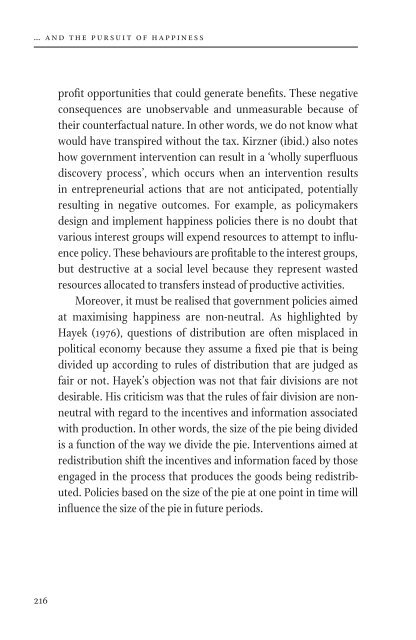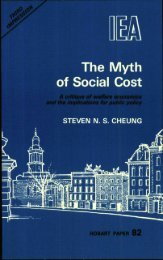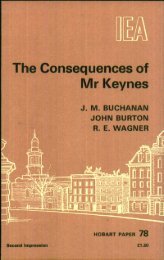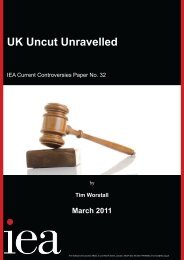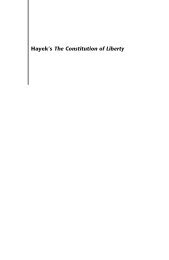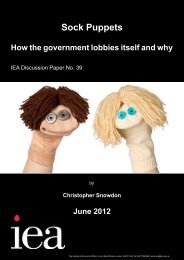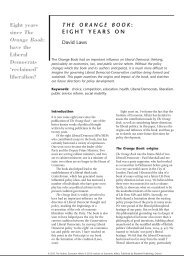… and the Pursuit of Happiness - Institute of Economic Affairs
… and the Pursuit of Happiness - Institute of Economic Affairs
… and the Pursuit of Happiness - Institute of Economic Affairs
You also want an ePaper? Increase the reach of your titles
YUMPU automatically turns print PDFs into web optimized ePapers that Google loves.
<strong>…</strong> <strong>and</strong> <strong>the</strong> pursuit <strong>of</strong> happiness<br />
lessons <strong>the</strong> from unbearable austrian lightness <strong>and</strong> public <strong>of</strong> choice happiness economics policy<br />
pr<strong>of</strong>it opportunities that could generate benefits. These negative<br />
consequences are unobservable <strong>and</strong> unmeasurable because <strong>of</strong><br />
<strong>the</strong>ir counterfactual nature. In o<strong>the</strong>r words, we do not know what<br />
would have transpired without <strong>the</strong> tax. Kirzner (ibid.) also notes<br />
how government intervention can result in a ‘wholly superfluous<br />
discovery process’, which occurs when an intervention results<br />
in entrepreneurial actions that are not anticipated, potentially<br />
resulting in negative outcomes. For example, as policymakers<br />
design <strong>and</strong> implement happiness policies <strong>the</strong>re is no doubt that<br />
various interest groups will expend resources to attempt to influence<br />
policy. These behaviours are pr<strong>of</strong>itable to <strong>the</strong> interest groups,<br />
but destructive at a social level because <strong>the</strong>y represent wasted<br />
resources allocated to transfers instead <strong>of</strong> productive activities.<br />
Moreover, it must be realised that government policies aimed<br />
at maximising happiness are non-neutral. As highlighted by<br />
Hayek (1976), questions <strong>of</strong> distribution are <strong>of</strong>ten misplaced in<br />
political economy because <strong>the</strong>y assume a fixed pie that is being<br />
divided up according to rules <strong>of</strong> distribution that are judged as<br />
fair or not. Hayek’s objection was not that fair divisions are not<br />
desirable. His criticism was that <strong>the</strong> rules <strong>of</strong> fair division are nonneutral<br />
with regard to <strong>the</strong> incentives <strong>and</strong> information associated<br />
with production. In o<strong>the</strong>r words, <strong>the</strong> size <strong>of</strong> <strong>the</strong> pie being divided<br />
is a function <strong>of</strong> <strong>the</strong> way we divide <strong>the</strong> pie. Interventions aimed at<br />
redistribution shift <strong>the</strong> incentives <strong>and</strong> information faced by those<br />
engaged in <strong>the</strong> process that produces <strong>the</strong> goods being redistributed.<br />
Policies based on <strong>the</strong> size <strong>of</strong> <strong>the</strong> pie at one point in time will<br />
influence <strong>the</strong> size <strong>of</strong> <strong>the</strong> pie in future periods.<br />
What ‘public goods’?<br />
As noted earlier, many happiness scholars conclude that a policy<br />
<strong>of</strong> taxing labour <strong>and</strong> certain goods is a way to resolve <strong>the</strong> progress<br />
paradox. Not only will this resolve <strong>the</strong> paradox, <strong>the</strong>y contend, but<br />
<strong>the</strong> tax revenue can <strong>the</strong>n be used to fund public goods that benefit<br />
society. Little focus or discussion, however, ever surrounds how<br />
policymakers will actually make decisions regarding <strong>the</strong> allocation<br />
<strong>of</strong> tax revenue to <strong>the</strong>se public goods. To underst<strong>and</strong> <strong>the</strong> practical<br />
issues at work, consider <strong>the</strong> st<strong>and</strong>ard logic behind public good<br />
provision.<br />
A pure public good has two specific characteristics. The first<br />
characteristic is that it is non-rivalrous, meaning that one individual’s<br />
consumption does not reduce o<strong>the</strong>rs’ ability to consume<br />
<strong>the</strong> good. The second characteristic is that it is non-excludable,<br />
which means that once <strong>the</strong> good is produced, individuals cannot<br />
be prevented from consuming <strong>the</strong> good. In <strong>the</strong>ory, public goods<br />
are under-supplied on <strong>the</strong> unhampered market because <strong>of</strong> issues<br />
associated with free-riding <strong>and</strong> pricing. The st<strong>and</strong>ard solution to<br />
problems associated with public goods is some combination <strong>of</strong><br />
government provision <strong>and</strong> government subsidies to correct for <strong>the</strong><br />
shortfall. Practical difficulties emerge, however, in <strong>the</strong> movement<br />
from <strong>the</strong>ory to practice to solve <strong>the</strong> public good problem.<br />
The core problem is obtaining <strong>the</strong> knowledge necessary to<br />
provide <strong>the</strong> ‘right’ amount <strong>of</strong> <strong>the</strong> good. Market failures emerge<br />
from <strong>the</strong> inability <strong>of</strong> unhampered markets to achieve allocative<br />
efficiency – in <strong>the</strong> case <strong>of</strong> public goods this results in an undersupply<br />
<strong>of</strong> <strong>the</strong> good. In <strong>the</strong>ory, government interventions can<br />
contribute to <strong>the</strong> achievement <strong>of</strong> this ideal by increasing production.<br />
This justification for government intervention in <strong>the</strong> market<br />
assumes, however, that government agents know <strong>the</strong> optimal level<br />
216 217


